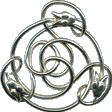Memoirs of Lloyd Moss: 1910 - 1914
In September, 1913, I started school though I was only six and the school rule was sever. Mother prevailed on the authorities to accept me early. My first grade teacher was Miss Grace Beal and I liked her very much and used to bring many things to school - colored leaves, butterfly chrysalis etc., and I thought I was teacher's pet that year. The school was called a model for that era and seemed to have some connection with William and Mary College close by. Our class was taken to the college for medical check-ups etc., and I was given a note to take home that stated that I had chronic catarrh. I never in my whole life heard any more about that. I did well in reading but not so well in arithmetic or spelling. This was quite a progressive school for a sleepy southern town. It was located on the spot where the restored Governor's Palace is now. We didn't know it then, but the old foundation of the palace had been leveled to the ground and the school erected over it, so the Historic Williamsburg Committee later uncovered the whole original layout of the palace very easily. In front of the school was an old brick wall and a large mock-orange tree. A portion of the wall, and the tree were left in place, at least until 1955 when I saw them last.
In back of the school it was evident even to us children that there had been a nice garden there at some point because of interesting bushes among the weeds, and nice flowers that came up in the spring. Someone hid colored eggs there for us to hunt one Easter. Beyond the garden was a little-used road (now Lafayette Street) and the C. and O. railroad tracks. Next to the tracks was a knitting mill from which came machinery noises and cotton-like fluff that would blow around and get caught on the fences and in the trees.
If we walked to the left down the track we came to a low, brick, domed structure partly broken in. If we looked inside we could see a deep, circular brick well where the older boys said prisoners had been kept during the war. It didn't look like a water well because the bottom was dry and paved with bricks and of course, we didn't know which war - or even if there had been more than one war. We played war sometimes using reeds that grew nearby as spears. There was a trestle a little further along where the road went over a ravine, and sometimes we boys would take our lunch bags and eat under there. One day a friend exchanged his hard-boiled duck egg for my hen egg, and when I told mother about it she seemed upset. She wanted to know the boy's last name, etc. It was a novelty to me, and I ate it, but didn't think it was very good. If we turned to the right along the track we soon came to the C. and O. freight station, but the freight agent wouldn't stand for boys hanging around anywhere near there.
In front of the school was the nice long Palace Green which went all the way down to Duke of Gloucester Street, but was "not for playing on". Along the street on the north side was a row of very curious, gnarled, old mulberry trees that we were told were planted for silkworms to eat when someone tried to start a silk-business sometime in the past. On the south side of the Green in back of the now-called Brush Everard House, perhaps on North England Street, there was a house where two classmates lived - a boy and a girl. Neither their father or mother ever seemed to be home and we kids were sometimes invited in to race around the place, but we never felt very comfortable doing it because it was so alien to anything the rest of us could to in our own homes. The side walk here, as well as many other places in the town, was bordered with stinging nettle and it was the accepted thing to push any unwary kid up against them with unhappy results for the victim. Sometimes it led to a fight then and there.
In September, 1914, I went into the second grade and my teacher was Miss Pinky Mocahn, an old maid type who lived with her family on Francis Street opposite the Capitol Green. I didn't get along so well with her and it got worse as time went on. I also began having small scraps with other boys. I was sent home once for defending myself by swinging my books on the end of a strap onto a boy's head. Except for reading I was not in the top third of my class. In retrospect, I can see how I got off to a bad start at this period. Miss Pinky's method of teaching was to submit questions and ask for a show of hands for the answers. It was here that I was caught because, having done so well in the first grade, I assumed that I should be first in answering, so automatically I raised my hand an guessed at an answer which turned out to be wrong fifty percent of the time. What I didn't know was that I had a slower-acting brain than some of the others. Too bad someone didn't recognize the difficulty then and point out that Thomas Edison also was far from being quick on the trigger as a boy.
